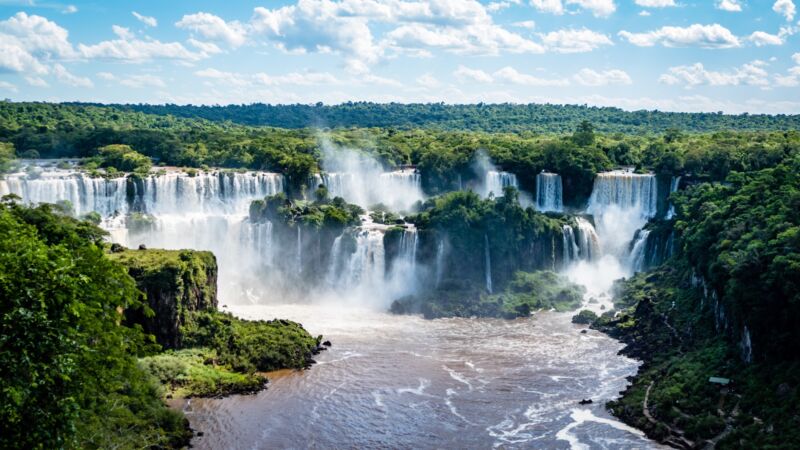

Argentina lost one-fifth of its Atlantic Forest in the last four decades
source link: https://arstechnica.com/science/2023/02/argentina-lost-one-fifth-of-its-atlantic-forest-in-the-last-four-decades/
Go to the source link to view the article. You can view the picture content, updated content and better typesetting reading experience. If the link is broken, please click the button below to view the snapshot at that time.
New tools —
Argentina lost one-fifth of its Atlantic Forest in the last four decades
Deforestation in tropical South America extends beyond the Amazon basin.
Alejandro Manrique - 2/10/2023, 6:53 PM

Deforestation not only causes the loss of important natural resources, it also contributes to global warming. Deforestation is the cause of about 20 percent of carbon dioxide emissions globally, which is higher than both passenger vehicles and trucks emit.
Large-scale deforestation of the Amazon began several decades ago and has accelerated in recent years, placing Brazil among the countries with the most. But the loss of forests in South America is not an Amazon-specific issue. According to a recent report released by MapBiomas, Argentina has lost almost 20 percent of the Atlantic Forest in the last 37 years.
The Atlantic Forest
The Atlantic Forest is a region shared among Argentina (3 percent), Brazil (90 percent), and Paraguay (7 percent). It is composed of tropical and subtropical rainforests extending more than 3,000 kilometers along the Brazilian Atlantic coast and runs inland to the west for almost 1,000 kilometers from the sea, reaching Northeast Argentina and Eastern Paraguay.
This complex eco-region is home to beautiful natural scenery and boasts an incredible biological wealth as well as a rich cultural diversity with 150 million inhabitants—about one-third of the population of South America.
This forest keeps alive a surprising diversity of life forms, with 7 percent of the planet’s plant species and 5 percent of vertebrate species living here. The importance of this eco-region for global biodiversity and people is remarkable, and it provides the goods and services for the livelihood and well-being of the inhabitants.
In the last 40 years, the area of the Atlantic Forests has been significantly reduced; today, only 20 percent of the original forest remains. More than 80 percent of the original area has experienced some deforestation, threatening many plant and animal species with extinction. This makes it one of the most threatened subtropical forests in the world.
AdvertisementDespite the fact that it has a third of its native vegetation, the Atlantic Forest remains particularly rich in biodiversity and endemic species, many of which are threatened with extinction.
MapBiomas, an evolving platform
That decline makes the Atlantic Forests a major focus of MapBiomas, a network of NGOs, research institutions, and technology startups that produces and promotes the use of high-quality data on land use and land cover management in South America and other tropical regions. The network collects data, information, methods, and tools to improve the decision-making process for conservation and sustainable management of natural resources.
The MapBiomas Trinational Atlantic Forest is one of the ongoing initiatives that are currently part of the MapBiomas network (the rest being Brazil, Amazonia, Chaco, Pampa Trinational, and Indonesia) in which a group of experts in cartography, environmental management, geography, and remote-sensing from Argentina, Brazil, and Paraguay generated the land cover and land use maps of the Atlantic Forest, starting with data from 1985.
The details of the work were released in early October 2022 at a regional conference. The new edition, MapBiomas Trinational Atlantic Forest 2.0, is the outcome of a collaborative network of specialists in areas such as land use, satellite remote sensing, Geographic Information Systems (GIS), and programming.
Through the Trinational Atlantic Forest platform, annual land cover and land use maps were created covering the years from 1985 to 2021. The new collection of maps showed that the biome lost 11 percent of its native vegetation in the past 37 years. In Argentina specifically, 300,000 hectares of forest were lost, meaning that almost 20 percent of the forests that existed in 1985 are now gone—an average rate of 8,000 hectares per year, an area equivalent to more than 11,000 soccer fields. The land occupied by these ecosystems is now used for agriculture, forestry, and pastures. The largest change was in the area occupied by forest plantations, which went from 130,000 hectares in 1985 to 330,000 hectares in 2021.
Recommend
About Joyk
Aggregate valuable and interesting links.
Joyk means Joy of geeK